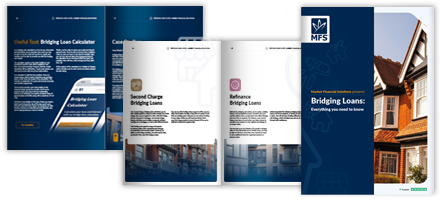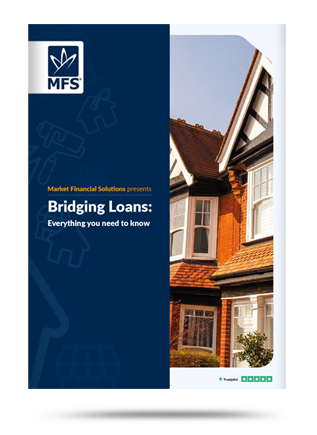
Written by Scott Lord
Deputy Chief Mortgage & Operations Officer – Front End
Market Financial Solutions are a bridging loan and buy-to-let mortgage provider and are not legal, financial, investment or tax advisers. This document is for informational purposes only and does not, and should not be considered, to constitute legal, financial, investment or tax advice or be relied upon by any person to make a legal, financial, investment or tax decision. Therefore, Investors are encouraged to seek appropriate professional advice. The information in this content is correct at time of writing.

To an extent, all bridging loans are investor bridging loans. Bridging loans are short-term forms of finance that are typically used to “bridge the gap” between purchases/investments.
They’re used by borrowers who want to invest in something, but are waiting for funds to become available from another transaction. A prime example is where an investor may be stuck in a property chain – a bridging loan can help them secure a property, while they wait for another one to sell.
But, generally, investors can use bridging loans for nuanced, tailored solutions. For instance, investors with missed payments on their records may face a prolonged, difficult process with high street banks. Whereas investor bridging loans can likely accommodate these kinds of circumstances more easily.
Or, say an investor plans to purchase an asset at auction. Auction houses tend to need to have bids wrapped up within 28 days. Mainstream lenders are unlikely to be able to deliver funding in time for that deadline, but an investor bridging loan can potentially be issued within days of an enquiry.
While it’s relatively straightforward to get one’s head around the utility of an investor bridging loan, there are a broad range of applicable circumstances that could be explored. As such, this blog will outline how investors could utilise bespoke finance.
How could investor bridging loans be put to use?
Investor bridging loans are primarily used for property investments. We are not wealth/financial advisors here at Market Financial Solutions, we will never guide our borrowers on how they should invest. What will work for a borrower will depend on their circumstances and if they feel they need help on what to do, they should seek external advice.
But, generally, investors look to spread their capital across a range of investments and asset classes. By diversifying, investors can protect themselves where certain assets fall in value. If an investor’s UK shares fall in value, their commodity or property investments may be able to pick up the slack, for example.
Interactive Investor explored how this works in practice recently[1]. Utilising existing data, it showed what happened to a portfolio with a £140,000 investment in 14 separate asset classes (£10,000 each) over the prior 20 years. This included UK real estate, government bonds, gold, and various equities.
By the end of the 20 years, the entire portfolio returned 460%. The £10,000 invested in one area however, generated a return of just over 68%.
Investor bridging loans can help with the real estate side of things as well as other investments and endeavours. For instance, firms can use business bridging loans to expand their headcount, or invest in new machinery.
Investor bridging loans can also facilitate capital raising, allowing borrowers to get their plans off the ground. What needs to be remembered is that at Market Financial Solutions, regardless of how our funds are utilised, all our loans must be secured against property. We also need to see a clearly definied and thought out exit strategy.

The property types and strategies available
Bridging loan investment can involve many different types of properties, and strategies. Investors themselves can also come to us via several means, including as an individual, as a corporate entity, or through an offshore set up.
Our funding can be used for a broad range of property types, from standard residential houses, through to largescale commercial hubs. Also, we have products designed to accommodate specific circumstances.
Our development exit loans are there for developers who are coming to the end of a major project, while second charge funding is available where investors want to utilise existing assets.
Moreover, all our bridging products prioritise flexibility and speed above all else. Meaning, they’re there for borrowers engaging in a range of investment strategies. Those purchasing a property for a fix-and-flip strategy – where a property is bought, improved, and sold on at a higher value – can use our permitted and light development loans for their renovation plans.
Our overseas bridging finance is there for foreign nationals looking to break into the UK property market. What’s more, semi-commercial and commercial bridging loans are available for potential conversion strategies, where investors plan to turn commercial spaces into residential homes or vice-versa.
Why do investors need to keep on top of their options?
Investors will likely need to utilise all the tools at their disposal to get ahead in the property market. Simply put, it’s becoming increasingly competitive in the English and Welsh property scene.
First-time buyers and others are being priced out of the property market at the moment, as US based “mega-landlords” are buying up new build stock[2]. Private equity firms ramped up investment in new-build rental homes in 2023 which, according to Knight Frank, reached record levels.
Indeed, according to HMRC, overseas buyers accounted for 1.4% of UK property transactions in the year ending March 2023, a 20% jump on the year prior[3]. What’s more, in 2024, Britain may prove more tempting for international property investors than the rest of Europe. Investors from the U.S, Israel, Japan, and Taiwan are set to pour capital into the UK market over the coming months, according to Savills[4].
On top of this competition from overseas, domestic investors also need to keep on top of their local competitors. Our own independent research from Q1 2024 showed that, despite facing a challenging 2023, many UK investors remain confident for the remainder of the year. And specifically, BTL assets, student accommodation, and residential property (not to be let) are proving tempting.
Investor bridging loans will likely prove crucial over the coming months for investors who want to get ahead of all this demand. Brokers in need of bridging loan investment solutions for their eager borrowers should reach out to us today.
The Complete Guide to
Bridging Loans
Everything you need to know
- Different bridging types
- Useful tools
- Apply them in real life
- Market insights & more
[1] https://www.ii.co.uk/analysis-commentary/portfolio-diversification-action-see-how-it-really-works-ii529152
[2] https://inews.co.uk/news/first-time-buyers-landlords-uk-new-builds-2926558
[3] https://www.mortgagestrategy.co.uk/analysis/buy-to-let-watch-overseas-buyers-on-the-up/
[4] https://www.cnbc.com/2024/03/01/uk-europe-real-estate-to-surge-as-buyers-eye-investment-opportunities.html





